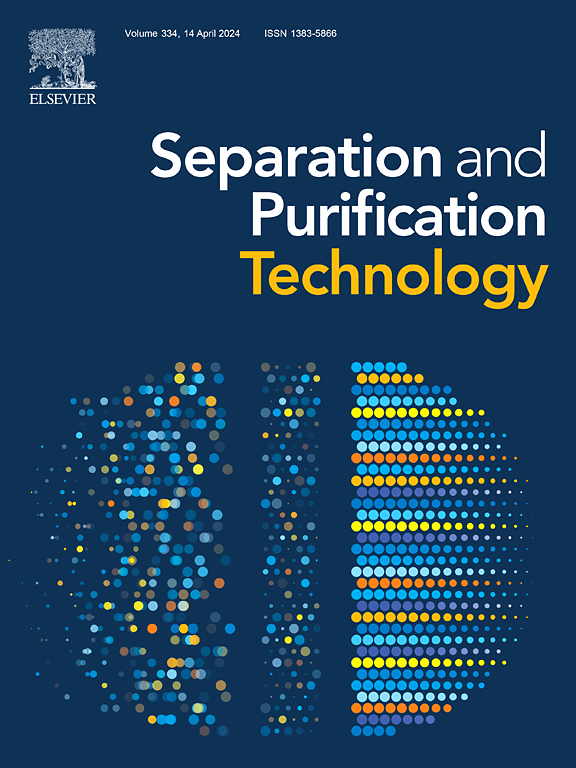基于电场下直接电子转移的双金属铁钴对氟苯尼考的脱卤性能研究
IF 8.1
1区 工程技术
Q1 ENGINEERING, CHEMICAL
引用次数: 0
摘要
对卤代抗生素进行脱卤处理是消除其毒性的一种有效的预处理方法。在这项研究中,开发了一种新的电极,利用单步电沉积技术在泡沫铜(CF)上原位生成双金属铁钴纳米颗粒。利用合成的正极材料(Fe@Co/CF)对代表性卤化抗生素氟苯尼考(C12H14Cl2FNO4S, FLO)进行电化学还原脱卤。通过密度泛函理论(DFT)计算证明了铁钴双金属表面存在正电荷,增强了C-Cl键的吸附,降低了活化能。在10 mA和pH 6.0的最佳条件下,Fe@Co/CF对FLO的去除率为bbb99 %,FLO的脱氯效率约为83 %,明显优于其他正极材料。Fe@Co/CF对其他氯代抗生素具有良好的处理效果。Fe@Co/CF对FLO脱卤的主要机理是直接电子转移(DET),铁钴双金属的协同作用增强了直接电子转移的作用。在电化学还原脱卤过程中,FLO依次分解为C12H14ClFNO4S,再分解为C12H14FNO4S,显著降低了生物毒性。经过实际水处理和循环,Fe@Co/CF仍保持较高的处理效率。本研究开发的卤化抗生素脱卤电极在去除废水中卤化污染物方面具有很大的潜力。本文章由计算机程序翻译,如有差异,请以英文原文为准。


Dehalogenation performance of florfenicol by bimetallic iron-cobalt based on direct electron transfer under electric field
Dehalogenation of halogenated antibiotics is an effective pretreatment method aimed to eliminate the toxicity. In this study, a novel electrode was developed utilizing single-step electrodeposition for the in-situ generation of bimetallic iron-cobalt nanoparticles on copper foam (CF). The synthesized cathode material (Fe@Co/CF) was utilized for the electrochemical reductive dehalogenation of florfenicol (C12H14Cl2FNO4S, FLO), a representative halogenated antibiotic. The presence of a positive charge on the surface of the bimetallic iron-cobalt was proved by density functional theory (DFT) calculations, enhancing the adsorption of the C-Cl bond and reducing the activation energy. The removal of FLO was >99 % under the optimal conditions of 10 mA and pH 6.0 by Fe@Co/CF and the dechlorinating efficiency of FLO was approximately 83 %, which was significantly superior to other cathode materials. Great treatment performance on Fe@Co/CF for other chlorinated antibiotics was demonstrated. The primary mechanism for FLO dehalogenation by Fe@Co/CF was direct electron transfer (DET), which was augmented by the synergistic effect of the bimetallic iron-cobalt. During the electrochemical reductive dehalogenation, FLO was sequentially decomposed to C12H14ClFNO4S and then to C12H14FNO4S, significantly reducing biotoxicity. After practical water treatment and cycles, high treatment efficiency of Fe@Co/CF was maintained. The developed electrode for the dehalogenation of halogenated antibiotics in this study has demonstrated great potential for dechlorinating halogenated pollutants in wastewater.
求助全文
通过发布文献求助,成功后即可免费获取论文全文。
去求助
来源期刊

Separation and Purification Technology
工程技术-工程:化工
CiteScore
14.00
自引率
12.80%
发文量
2347
审稿时长
43 days
期刊介绍:
Separation and Purification Technology is a premier journal committed to sharing innovative methods for separation and purification in chemical and environmental engineering, encompassing both homogeneous solutions and heterogeneous mixtures. Our scope includes the separation and/or purification of liquids, vapors, and gases, as well as carbon capture and separation techniques. However, it's important to note that methods solely intended for analytical purposes are not within the scope of the journal. Additionally, disciplines such as soil science, polymer science, and metallurgy fall outside the purview of Separation and Purification Technology. Join us in advancing the field of separation and purification methods for sustainable solutions in chemical and environmental engineering.
 求助内容:
求助内容: 应助结果提醒方式:
应助结果提醒方式:


